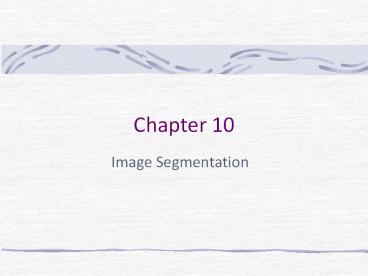Image Segmentation - PowerPoint PPT Presentation
1 / 45
Title:
Image Segmentation
Description:
... Basic Adaptive Thresholding (cont d) Optimal Global and Adaptive Thresholding Refer to Chapter 2 of the Pattern Classification textbook by Duda, ... – PowerPoint PPT presentation
Number of Views:179
Avg rating:3.0/5.0
Title: Image Segmentation
1
Chapter 10
- Image Segmentation
2
Preview
- Segmentation subdivides an image into its
constituent regions or objects. - Level of division depends on the problem being
solved. - Image segmentation algorithms generally are based
on one of two basic properties of intensity
values discontinuity (e.g. edges) and similarity
(e.g., thresholding, region growing, region
splitting and merging)
3
Chapter Outline
- Detection of discontinuities
- Edge linking and boundary detection
- Thresholding
- Region-based segmentation
- Morphological watersheds
- Motion in segmentation
4
Detection of Discontinuities
- Define the response of the mask
- Point detection
5
Point Detection Example
6
Line Detection
- Masks that extract lines of different directions.
7
Illustration
8
Edge Detection
- An ideal edge has the properties of the model
shown to the right - A set of connected pixels, each of which is
located at an orthogonal step transition ingray
level. - Edge local concept
- Region Boundary global idea
9
Ramp Digital Edge
- In practice, optics, sampling and other image
acquisition imperfections yield edges that area
blurred. - Slope of the ramp determined by the degree of
blurring.
10
Zero-Crossings of 2nd Derivative
11
Noisy Edges Illustration
12
Edge Point
- We define a point in an image as being an edge
point if its 2-D 1st order derivative is greater
than a specified threshold. - A set of such points that are connected according
to a predefined criterion of connectedness is by
definition an edge.
13
Gradient Operators
- Gradient
- Magnitude
- Direction
14
Gradient Masks
15
Diagonal Edge Masks
16
Illustration
17
Illustration (contd)
18
Illustration (contd)
19
The Laplacian
- Definition
- Generally not used in its original form due to
sensitivity to noise. - Role of Laplacian in segmentation
- Zero-crossings
- Tell whether a pixel is on the dark or light side
of an edge.
20
Laplacian of Gaussian
- Definition
21
Illustration
22
Edge Linking Local Processing
- Link edges points with similar gradient magnitude
and direction.
23
Global Processing Hough Transform
- Representation of lines in parametric space
Cartesian coordinate
24
Hough Transform
- Representation in parametric space polar
coordinate
25
Illustration
26
Illustration (contd)
27
Graphic-Theoretic Techniques
- Minimal-cost path
28
Illustration
29
Example
30
Thresholding
- Foundation background point vs. object point
- The role of illumination f(x,y)i(x,y)r(x,y)
- Basic global thresholding
- Adaptive thresholding
- Optimal global and adaptive thresholding
- Use of boundary characteristics for histogram
improvement and local thresholding - Thresholds based on several variables
31
Foundation
32
The Role of Illumination
33
Basic Global Thresholding
34
Another Example
35
Basic Adaptive Thresholding
36
Basic Adaptive Thresholding (contd)
37
Optimal Global and Adaptive Thresholding
- Refer to Chapter 2 of the Pattern
Classification textbook by Duda, Hart and Stork.
38
Thresholds Based on Several Variables
39
Region-Based Segmentation
- Let R represent the entire image region. We may
view segmentation as a process that partitions R
into n sub-regions R1, R2, , Rn such that - (a)
- (b) Ri is a connected region
- (c)
- (d) P(Ri) TRUE for i1,2,n
- (e) P(Ri U Rj) FALSE for i ! j
40
Region Growing
41
Region-Splitting and Merging
42
Morphological Watersheds (I)
43
Morphological Watersheds (II)
44
Motion-based Segmentation (I)
45
Motion-based Segmentation (II)

